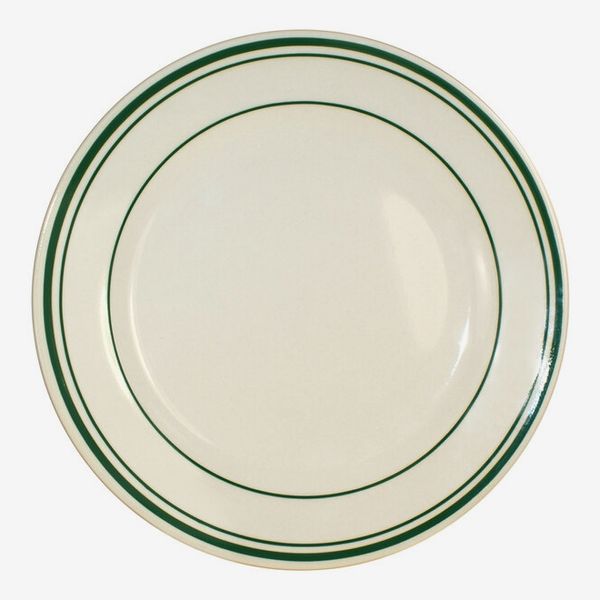
Recently, I had back-to-back dinners at two very different neighborhood spots in Brooklyn: Café Spaghetti, an Italian joint with platters of homey food, and Bar Bête, a more-refined-in-vibe French-inspired bistro. During the second meal, as I scarfed down duck-fat potatoes, I noticed that both use the same bistro-style — or, depending on how you think of them, diner-style — plates: thick, porcelain, and off-white with a few green circles snaking their way around the edge.
As I ate out in the city and scrolled through Instagram over the following several months, they popped up again and again. (The green rim is the most common I’ve seen, but there’s also blue, black, brown, and maroon, plus plenty of all-white scalloped-edge ones in the same material.) They’re at the aforementioned Café Spaghetti and Bar Bête, at Superiority Burger, Golden Diner, Café Mutton, El Pinguino, Ingas, Agi’s Counter, Yellow Rose, Red Hook Tavern, Leo, and The HiHi Room (before it closed a few months back). I’ve noticed custom ones at Bad Roman, Raf’s, and Gage & Tollner, too. Admittedly, some of these restaurants are takes on archetypal bistros and diners that give the plates their name — but some definitely aren’t.
“It just feels like a plate that’s really classic — really classic to New York,” says Jon Neidich, chief executive of Golden Age Hospitality, the group that owns and designed Le Dive, another spot that uses them. This is in line with what my colleague over at Grub Street, Matthew Schneier, just wrote about: the “rise of the Fauxdeon,” or a noticeable number of new takes on the dimly lit, somewhat rowdy (even naughty), see-and-be-seen brasseries that have defined the city’s dining scene for decades. (Indeed, you’ll notice another custom bistro plate at the few-weeks-old Hoexter’s mentioned in the story.)
I own more than a dozen of them myself in salad and dessert sizes, scavenged nearly ten years ago from Fishs Eddy, the iconic downtown dishware store (and recently opened museum) stacked high with just this style, many of them vintage from decades-old or now-defunct restaurants. When I bought them, the goal was to be cheap. But all this time later, they’ve held up. This makes sense: The striking durability was another plus every chef and owner I spoke to mentioned.
“I think that we went through a big phase of really high-end ceramics in New York,” says Joey Scalabrino, owner of Leo. “But then you have a rowdy pizzeria that’s doing 300 people a day and you’re breaking stuff all the time. Those plates are $50 each — literally. That just becomes unsustainable.” Sal Lamboglia, owner of Café Spaghetti, says the runners at A Voce, where he worked many years ago, would be shaking when they delivered the china to the dish station. But I’ve never chipped, scratched, or broken a single one of these — good thing, since they’re my most-used and most-complimented ones.
The Strategist is designed to surface the most useful, expert recommendations for things to buy across the vast e-commerce landscape. Some of our latest conquests include the best acne treatments, rolling luggage, pillows for side sleepers, natural anxiety remedies, and bath towels. We update links when possible, but note that deals can expire and all prices are subject to change.









